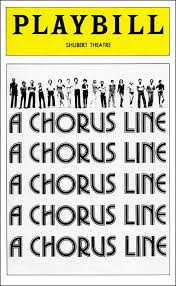
Blog: Behind the Line: The Creation of A Chorus Line

A Chorus Line Original Playbill Cover
The interviews began in a circle with each dancer stating their name, where they were born and why they started dancing. As the evening continued, the stories grew and encompassed everything from childhood traumas, insecurities, sexuality and more. The event lasted twelve hours, but there was still more to tell and another evening was scheduled and recorded. Bennett knew he had something with the material and pitched his idea to Joseph Papp, the founder of the New York Shakespeare Festival (NYSF), who loved it. Papp allowed Bennett an unprecedented amount of workshop time for the project and planned to open it in his theater complex, The Public Theater. Bennett then invited the other collaborators to the project.
Bennett drew from friends to help shape the piece. First was Nicholas Dante, one of the dancers at the interviews whose story turned into Paul’s moving monologue, to develop the book from the recordings. Then Bennett approached longtime collaborator Bob Avian to assist with choreography. He asked Marvin Hamlisch, then a three-time Academy Award® winner and Hollywood’s hottest composer, to write the score. Hamlisch had always wanted to write a Broadway musical and accepted. Edward Kleban would write the lyrics and later James Kirkwood came on as a co-bookwriter. However, Bennett was the one who drove the show.
The first workshop was on August 4, 1974. A Chorus Line is unique in its development. There was no real script to start with and each role was created organically, individually crafted to suit the talents and personality of the person playing it. Several dancers played versions of themselves and others played characters created from combining several different dancers’ stories. The cast members also contributed their own stories that enhanced the characters. Most fascinating was that all of the stories were true – and the process was deeply emotional for the cast who were used to not being allowed a voice in the creative process. From these character developments and personalities, Hamlisch and Kleban fashioned songs – for instance, they thought of the song that became “Sing!”during the actress’s poor singing audition. But it wasn’t until “At the Ballet” that they knew they had something special.
Throughout the development process, the cast and creative team worried that the show might be too insular, too focused on the business. They needn’t have worried. The show was a massive hit immediately after it premiered at The Public Theater. The glowing reviews poured in. Clive Barnes of The New York Times said, “the conservative word for A Chorus Line is tremendous, or perhaps terrific.” A Chorus Line quickly transferred to Broadway and had its first performance on July 25, 1975.
It is not an exaggeration to say that A Chorus Line saved Broadway. Broadway attendance was at a near all-time low of 6.6 million before the musical premiered. Afterwards, A Chorus Line shot the attendance up to 8.8 million, became the centerpiece for New York City tourist promotion and led to the revitalization of Times Square. In 1983, on its 3,389 performance, A Chorus Line became the longest running musical in Broadway history, a title it would hold until 1997.
One of the reasons A Chorus Line achieved such a blockbuster success was that its stories resonated with everyone – not just those who dance. While the stories came specifically from dancers, the experiences they described of childhood memories, adolescent awkwardness, loss and hope were universal. It was a show created specifically from the experiences of baby boomers, and strongly appealed to them. Even now, more than forty years later, the themes still resonate and A Chorus Line remains the one singular sensation.